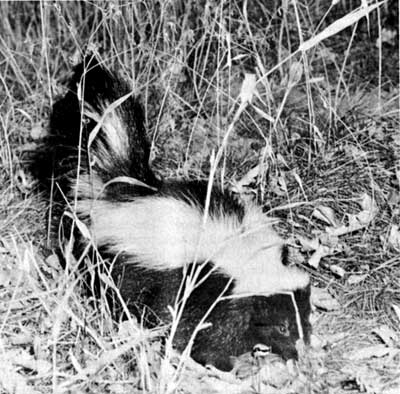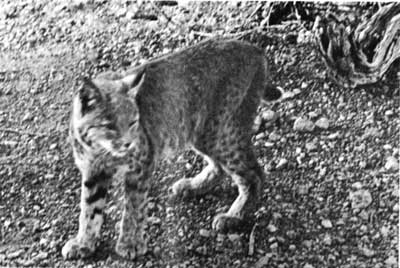|
AZTEC RUINS National Monument |
 |

Skunk.
The Natural Scene
Aztec Ruins National Monument is located on the Animas River in northwestern New Mexico, about 20 miles below the Colorado Stare line and 14 miles above the point where the Animas flows into the San Juan. The monument is on the west bank of the Animas on high ground about halfway between the river and the low-lying hills and mesas which border the river valley.
The valley, although narrow at spots, is about 2 miles wide at the point where the ruins are located. The floor of the valley is composed of fertile alluvial soil, which produces fine crops if irrigated. Today, as in prehistoric times, the population of this area is concentrated along the river. It was this permanent source of water that induced the builders of the Aztec pueblo, and in later times the white man, to settle this valley. No doubt many of the fields cultivated today are the same ones that were tilled by the original inhabitants of the area.
The valley floor and valley terraces are dotted with saltbush, rabbitbrush, greasewood, and sagebrush. The riverbanks and ditches are lined with willows and huge cottonwoods. Cattails and reeds grow in the marshy areas, and wild roses grow in the shady spots. The low hills and uplands bordering the river valley have a sparse cover of vegetation because of the small amount of rainfall. Therefore the main growth is juniper and pinyon. Typical of the Upper Sonoran Life Zone, these small, hardy trees can withstand dry periods and survive in semiarid country.

Porcupine.
Today much of the valley is under cultivation or in pasture, and the mild and very dry climate is well suited to growing non-citrus fruit. Elevation at the monument is about 5,600 feet above sea level. Average annual rainfall is about 9-1/2 inches; the humidity is usually very low. Temperatures will reach the mid-90's during July and August, but evenings are cool and pleasant. Night temperatures in the 60's are not uncommon even after the hottest summer days. Occasional afternoon thundershowers give relief from the heat during late July and August.
Spring and autumn are relatively dry seasons when the skies may remain cloudless for weeks at a time. In September a great range of temperature from night to day—as much as 45°—is noticeable.
The winters are mild. The temperature rarely drops to zero or below, and there are very few prolonged periods of cold weather. Infrequent snows are usually light, and melt quickly. Many days are warm and cloudless.

Bobcat.
At the time that the Aztec pueblo was inhabited, no doubt a few deer, pronghorn ("antelope"), and bighorn could be found in and near the valley. Occasionally, deer still may be seen along the river to the north of Aztec Ruins. Many of the smaller animals which were familiar to the people of the Aztec pueblo are still present in the valley and may occasionally be observed in the monument. Jackrabbits, cottontails, rock squirrels, skunks, porcupines, and an occasional gray fox, all of which were probably well known to the Pueblo people, frequent the monument. Gambel's quail and pheasants, which are both relative newcomers, may also be seen in the monument. Ducks, geese, and a few large shore birds may be seen along the river during the cooler months. Meadowlarks, robins, and numerous other birds may be seen during warmer months.
Several species of lizards and a few bullsnakes (which are harmless and beneficial and should not be disturbed) may be observed around the ruins area during summer.

|

|
|
Last Modified: Sat, Jan 13 2001 10:00:00 am PDT |


